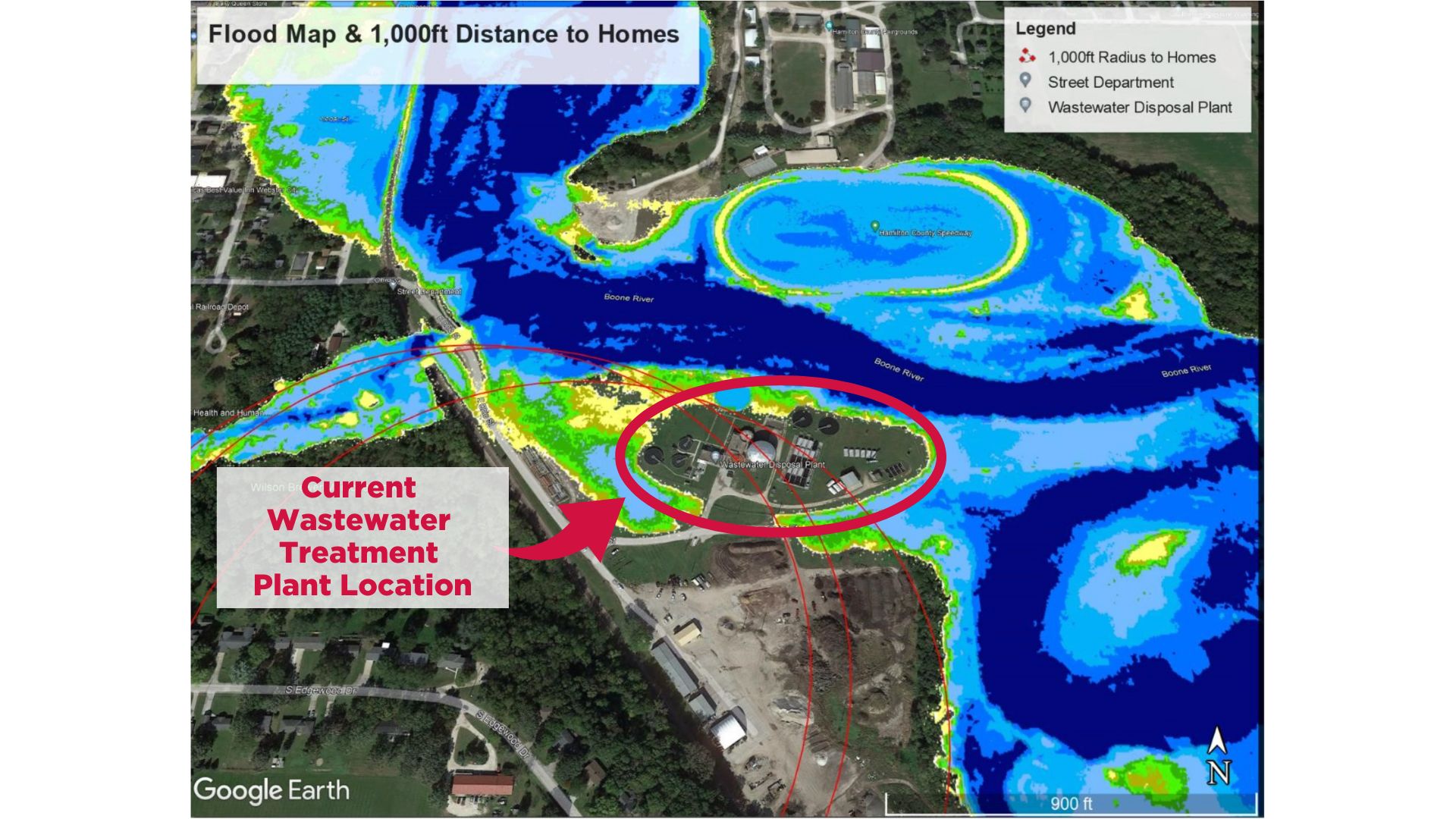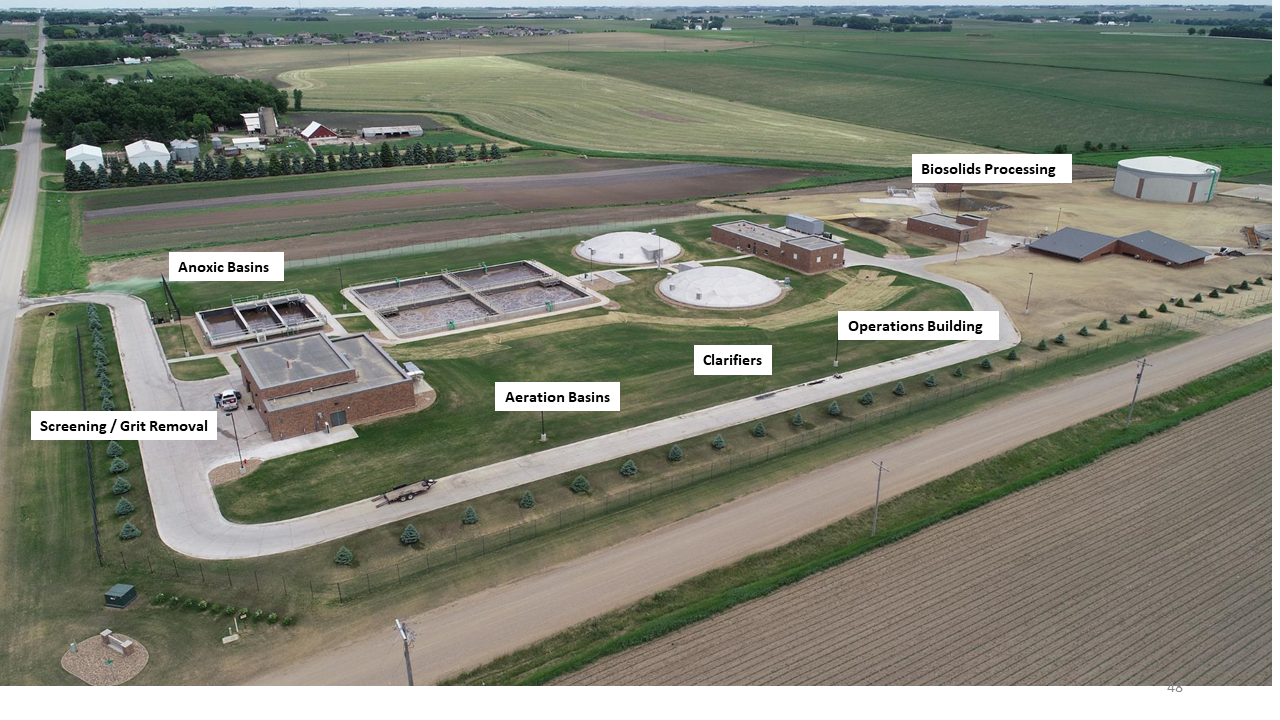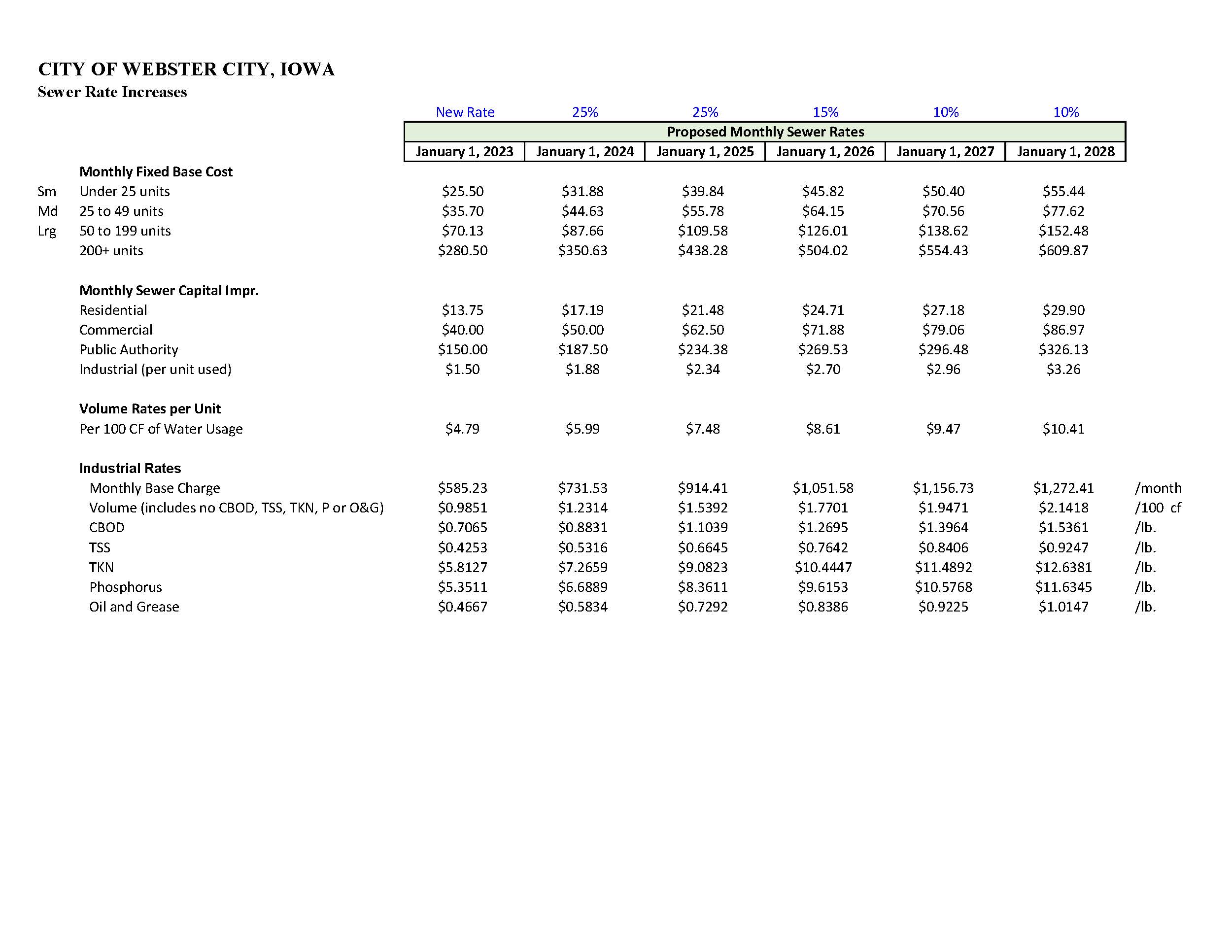Wastewater Treatment Plant Project
Project Overview
The City of Webster City Wastewater Treatment Plant was originally constructed in 1939 with five major upgrades over the past 83 years. The facility utilizes a fixed film technology where bacteria grow on rock and plastic media that is in contact with wastewater to break it down for discharging to the stream. The facility’s aging infrastructure, obsolete equipment, and tight space constraints of the existing treatment plant site will require significant improvements to maintain compliance with Iowa Department of Natural Resources (DNR) and US Environmental Protection Agency (EPA) regulations.
New requirements in the recently renewed National Pollutant Discharge Elimination System (NPDES) discharge permit include compliance with the Iowa Nutrient Reduction Strategy for removal of total nitrogen and phosphorus. In addition, the current facility is operating above rated capacity. Expected growth of the City and industrial users requires an increase in plant capacity. The City of Webster City completed this evaluation of alternatives for wastewater treatment facility improvements to meet the needs of the community over the next 20 years.
Modifications to the existing system were evaluated and found to be not economically feasible. The existing fixed-film process is not capable of significant total nitrogen and phosphorus removal as required by the Iowa Nutrient Reduction Strategy. Additionally, the existing treatment facility is at the end of its useful life and a major renovation is required. The existing plant site’s limited size and close proximity to housing and the flood plain make expansion at the current plant location not feasible.
The City needs to proceed with construction of a new extended aeration activated sludge plant with biological nitrogen and phosphorus removal at a site previously purchased by the City south of town. Extended aeration activated sludge is a robust treatment process with proven success achieving low ammonia and total nitrogen discharge concentrations.
Trickling Filter Biological
Part of the wastewater treatment facility. It consists of a fixed bed of rocks and moss. Wastewater flows downward and causes a layer of biofilm to grow on the rocks and moss. Aerobic (requiring oxygen) conditions are maintained by the arms splashing water on the fixed bed of rocks.

Rotating Biological Rotators
Rotating Biological Contactors or RBC’s is a fixed film treatment process used in secondary treatment of wastewater. The RBC process allows the wastewater to come in contact with a biological film in order to remove pollutants. RBC’s consists of a series of closely spaced parallel discs mounted on a rotating shaft. RBC’s are usually submerged 30% to 40%.
Fixed Film Media Biological
Fix film media has micro-organisms that grow. They build up on the media until they are sloughed off due to the rotating disc in the sewage.
Electrical Panel
Electrical panel that controls the set points for the wastewater plant operations.

- MGD – Million Gallons per Day – How plant design and discharge daily flow is measured
- mg/L – Milligrams per Liter – Method of expressing concentrations of contaminants equivalent to parts per million
- lbs/d – Pounds per day – Mass or weight of contaminant that is calculated based on flow (MGD) and concentration of contaminant (mg/L)
- BOD – Biochemical Oxygen Demand – A measure of the amount of oxygen used by microorganisms in the stabilization of organic matter in wastewater and an important parameter for protecting streams from low dissolved oxygen conditions
- TSS – Total Suspended Solids – Solids that can be removed by filtering a sample of wastewater. Excess TSS in discharge causes sedimentation and poor water clarity in streams
- TKN – Total Kjeldahl Nitrogen – Organic (protein) nitrogen plus ammonia nitrogen. This is an important parameter for protection of aquatic life from ammonia toxicity and controlling nutrient loads on streams and lakes. TKN is converted to nitrate in conventional treatment plants.
- Total Nitrogen is TKN plus Nitrate and Nitrite Nitrogen
Nutrients – Nitrogen and phosphorus in discharge to streams that cause excess growth of algae in streams, lakes and the Gulf of Mexico
The preliminary engineer’s cost opinion is $78,426,000. This estimate includes engineering, legal, financing, construction and construction administration costs as well as a 20% contingency. The City evaluated financing options through the USDA Water and Wastewater Loan and Grant Program, the Iowa State Revolving Fund Loan and Grant Program, FEMA – Building Resilient Infrastructure and Communities Grant, and the Wastewater and Drinking Water Treatment Financial Assistance Program.
After careful consideration and review of loan options, the City will pursue a State Revolving Fund Loan and actively apply for grant opportunities that arise to help fund the construction of the wastewater treatment plant construction.
Environmental Protection Water Quality Nutrient Reduction Strategy
Iowa Nutrient Reduction Strategy
Iowa DNR Nutrient Reduction Strategy
Adam Schnieders Iowa Nutrient Reduction Strategies
2017 Iowa Nutrient Reduction Strategy (Complete)
Establishing Trends in Iowa’s Rivers in Support of Iowa’s Nutrient Reduction Strategy
Timeline of Events
Planning began to address DNR Nutrient Reduction Strategy Requirements.
Completed Future Wastewater Treatment Plant Site Selection Process - Purchased Selected Site.
Potential Large Industrial User Discussions Regarding Design Loads.
Initial submittal of design loads to Department of Natural Resources (DNR).
City Council approves plant load with 25% reserve unallocated capacity for future.
Secure State Revolving Loan for Planning and Design Work needed.
Acquired two parcels of land needed for sewer force mains.
Revised submittal to DNR incorporating 25% reserve capacity for future, Waste Load Allocation Request submitted to DNR.
Received approval from DNR for design flows.
Received preliminary limits from one outfall alternative provided by DNR and submitted request for site review to DNR.
30-Day Antidegradation Public Review.
City Council approves Facility Plan submitted to DNR.
City Council adopts Resolution to pursue State Revolving Loan Fund Loan to pay for the construction of the new Wastewater Treatment Plant Project and approves first read of proposed sewer rate increases.
City Council approves second reading of proposed sewer rate increases.
City Council adopts the third reading of the proposed sewer rate adjustment and the new rates will take effect January 1, 2023.
DNR approves submitted Facility Plan.
City staff begins meeting with Moonshot Missions, a non-profit organization sponsored by the Environmental Protection Agency (EPA) to assist communities of our size in navigating costly projects such as the new Wastewater Treatment Plant.
City Council approves Amendment No. 2 with Bolton and Menk, Inc. for Professional Engineering Services needed to complete the design of the new Wastewater Treatment Plant.
The City Council approves Amendment No. 26 for Snyder & Associates to perform an engineering assessment of the existing WWTP Facility Plan at the recommendation of Moonshot Mission, consultant sponsored by EPA.
Mayor receives an engineering analysis of the City's WWTP Facility Plan completed by ISU Masters in Engineering student completed as part of his Masters thesis.
Snyder & Associates provides the final memo of their engineering analysis of the WWTP Facility Plan.
City Council has a work session to discuss the findings of both engineering assessments in depth. Council consensus was to proceed with the initial Wastewater Treatment Facility Plan with no revisions.
Anticipated Design and Construction Schedule
April 2024 – Complete design and submit construction permit application to DNR
September 2024 – Receive DNR construction permit and begin construction
November 2026 – Complete construction
*This schedule is subject to change based on supply chain and market conditions.
Copyright ©2024 City of Webster City. All rights reserved. Website created by inTANDEM marketing.







